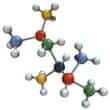Background
- Taurine, or 2-aminoethanesulfonic acid, was originally discovered in ox (Bos taurus) bile and was named after taurus, or bull. A nonessential amino acid-like compound, taurine is found in high abundance in the tissues of many animals, especially sea animals, and in much lower concentrations in plants, fungi, and some bacteria. As an amine, taurine is important in several metabolic processes of the body, including stabilizing cell membranes in electrically active tissues, such as the brain and heart. It also has functions in the gallbladder, eyes, and blood vessels, and may have some antioxidant and detoxifying properties.
- Taurine is a constituent of some energy drinks, including Red Bull®. Numerous clinical trials suggest Red Bull® and similar energy drinks may be effective in reducing fatigue, and improving mood and endurance. However, these drinks contain other ingredients, which may also offer benefit in these areas, including caffeine and glucuronolactone. The effect of taurine alone in energy drinks has not been studied. Thus, the effectiveness of taurine in energy drinks is unclear and further research is still required.
- Several taurine derivatives are being investigated for medical use, such as taltrimide as an antiepileptic drug. Other taurine derivatives in various stages of development include acamprosate (antialcoholic), tauromustine (anticancer), and tauroursodeoxycholic acid (liver disorders).
- The efficacy of taurine has been investigated for diabetes, hypertension (high blood pressure), cystic fibrosis, liver disorders, cardiovascular disorders, and nutritional support. Although promising in many fields, additional study is needed before a firm recommendation can be made for these indications. Taurine is added to many infant formulas based on the decreased ability to form taurine from cysteine in this population.
References
- Azuma J, Sawamura A, Awata N, et al. Therapeutic effect of taurine in congestive heart failure: a double-blind crossover trial. Clin.Cardiol. 1985;8(5):276-282.
View Abstract - Balkan J, Oztezcan S, Hatipoglu A, et al. Effect of a taurine treatment on the regression of existing atherosclerotic lesions in rabbits fed on a high-cholesterol diet. Biosci Biotechnol Biochem 2004;68(5):1035-1039.
View Abstract - Colombo C, Battezzati PM, Podda M, et al. Ursodeoxycholic acid for liver disease associated with cystic fibrosis: a double-blind multicenter trial. The Italian Group for the Study of Ursodeoxycholic Acid in Cystic Fibrosis. Hepatology 1996;23(6):1484-1490.
View Abstract - Hagar HH, El Etter E, Arafa M. Taurine attenuates hypertension and renal dysfunction induced by cyclosporine A in rats. Clin Exp Pharmacol Physiol 2006;33(3):189-196.
View Abstract - Li Q, Guo JC, Jin HB, et al. Involvement of taurine in penicillin-induced epilepsy and anti-convulsion of acupuncture: a preliminary report. Acupunct Electrother Res 2005;30(1-2):1-14.
View Abstract - Mas MR, Isik AT, Yamanel L, et al. Antioxidant treatment with taurine ameliorates chronic pancreatitis in an experimental rat model. Pancreas 2006;33(1):77-81.
View Abstract - Merli M, Bertasi S, Servi R, et al. Effect of a medium dose of ursodeoxycholic acid with or without taurine supplementation on the nutritional status of patients with cystic fibrosis: a randomized, placebo-controlled, crossover trial. J.Pediatr.Gastroenterol.Nutr. 1994;19(2):198-203.
View Abstract - Oriyanhan W, Yamazaki K, Miwa S, et al. Taurine prevents myocardial ischemia/reperfusion-induced oxidative stress and apoptosis in prolonged hypothermic rat heart preservation. Heart Vessels 2005;20(6):278-285.
View Abstract - Rakotoambinina B, Marks L, Badran AM, et al. Taurine kinetics assessed using [1,2-13C2]taurine in healthy adult humans. Am.J.Physiol Endocrinol.Metab 2004;287(2):E255-E262.
View Abstract - Smith LJ, Lacaille F, Lepage G, et al. Taurine decreases fecal fatty acid and sterol excretion in cystic fibrosis. A randomized double-blind trial. Am.J.Dis.Child 1991;145(12):1401-1404.
View Abstract - Spencer AU, Yu S, Tracy TF, et al. Parenteral nutrition-associated cholestasis in neonates: multivariate analysis of the potential protective effect of taurine. JPEN J Parenter.Enteral Nutr 2005;29(5):337-343.
View Abstract - Spohr C, Brons C, Winther K, et al. No effect of taurine on platelet aggregation in men with a predisposition to type 2 diabetes mellitus. Platelets. 2005;16(5):301-305.
View Abstract - Tabassum H, Rehman H, Banerjee BD, et al. Attenuation of tamoxifen-induced hepatotoxicity by taurine in mice. Clin Chim.Acta 2006;370(1-2):129-136.
View Abstract - Tyson JE, Lasky R, Flood D, et al. Randomized trial of taurine supplementation for infants less than or equal to 1,300-gram birth weight: effect on auditory brainstem-evoked responses. Pediatrics 1989;83(3):406-415.
View Abstract - Zhang M, Bi LF, Fang JH, et al. Beneficial effects of taurine on serum lipids in overweight or obese non-diabetic subjects. Amino.Acids 2004;26(3):267-271.
View Abstract







